5 books about Plant conservation
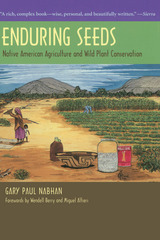
Enduring Seeds
Native American Agriculture and Wild Plant Conservation
Gary Paul Nabhan; Forewords by Wendell Berry and Miguel Altieri
University of Arizona Press, 2002
As biological diversity continues to shrink at an alarming rate, the loss of plant species poses a threat seemingly less visible than the loss of animals but in many ways more critical. In this book, one of America's leading ethnobotanists warns about our loss of natural vegetation and plant diversity while providing insights into traditional Native agricultural practices in the Americas.
Gary Paul Nabhan here reveals the rich diversity of plants found in tropical forests and their contribution to modern crops, then tells how this diversity is being lost to agriculture and lumbering. He then relates "local parables" of Native American agriculture—from wild rice in the Great Lakes region to wild gourds in Florida—that convey the urgency of this situation and demonstrate the need for saving the seeds of endangered plants. Nabhan stresses the need for maintaining a wide gene pool, not only for the survival of these species but also for the preservation of genetic strains that can help scientists breed more resilient varieties of other plants.
Enduring Seeds is a book that no one concerned with our environment can afford to ignore. It clearly shows us that, as agribusiness increasingly limits the food on our table, a richer harvest can be had by preserving ancient ways.
This edition features a new foreword by Miguel Altieri, one of today's leading spokesmen for sustainable agriculture and the preservation of indigenous farming methods.
Gary Paul Nabhan here reveals the rich diversity of plants found in tropical forests and their contribution to modern crops, then tells how this diversity is being lost to agriculture and lumbering. He then relates "local parables" of Native American agriculture—from wild rice in the Great Lakes region to wild gourds in Florida—that convey the urgency of this situation and demonstrate the need for saving the seeds of endangered plants. Nabhan stresses the need for maintaining a wide gene pool, not only for the survival of these species but also for the preservation of genetic strains that can help scientists breed more resilient varieties of other plants.
Enduring Seeds is a book that no one concerned with our environment can afford to ignore. It clearly shows us that, as agribusiness increasingly limits the food on our table, a richer harvest can be had by preserving ancient ways.
This edition features a new foreword by Miguel Altieri, one of today's leading spokesmen for sustainable agriculture and the preservation of indigenous farming methods.
[more]
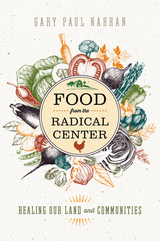
Food from the Radical Center
Healing Our Land and Communities
Gary Paul Nabhan
Island Press, 2018
"Informational and inspirational." —Booklist
America has never felt more divided. But in the midst of all the acrimony comes one of the most promising movements in our country’s history. People of all races, faiths, and political persuasions are coming together to restore America's natural wealth: its ability to produce healthy foods.
In Food from the Radical Center, Gary Nabhan tells the stories of diverse communities who are getting their hands dirty and bringing back North America's unique fare: bison, sturgeon, camas lilies, ancient grains, turkeys, and more. These efforts have united people from the left and right, rural and urban, faith-based and science-based, in game-changing collaborations. Their successes are extraordinary by any measure, whether economic, ecological, or social. In fact, the restoration of land and rare species has provided—dollar for dollar—one of the best returns on investment of any conservation initiative.
As a leading thinker and seasoned practitioner in biocultural conservation, Nabhan offers a truly unique perspective on the movement. He draws on fifty years of work with community-based projects around the nation, from the desert Southwest to the low country of the Southeast. Yet Nabhan’s most enduring legacy may be his message of hope: a vision of a new environmentalism that is just and inclusive, allowing former adversaries to commune over delicious foods.
America has never felt more divided. But in the midst of all the acrimony comes one of the most promising movements in our country’s history. People of all races, faiths, and political persuasions are coming together to restore America's natural wealth: its ability to produce healthy foods.
In Food from the Radical Center, Gary Nabhan tells the stories of diverse communities who are getting their hands dirty and bringing back North America's unique fare: bison, sturgeon, camas lilies, ancient grains, turkeys, and more. These efforts have united people from the left and right, rural and urban, faith-based and science-based, in game-changing collaborations. Their successes are extraordinary by any measure, whether economic, ecological, or social. In fact, the restoration of land and rare species has provided—dollar for dollar—one of the best returns on investment of any conservation initiative.
As a leading thinker and seasoned practitioner in biocultural conservation, Nabhan offers a truly unique perspective on the movement. He draws on fifty years of work with community-based projects around the nation, from the desert Southwest to the low country of the Southeast. Yet Nabhan’s most enduring legacy may be his message of hope: a vision of a new environmentalism that is just and inclusive, allowing former adversaries to commune over delicious foods.
[more]
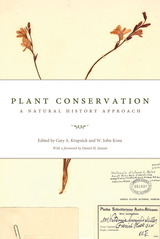
Plant Conservation
A Natural History Approach
Edited by Gary A. Krupnick and W. John Kress
University of Chicago Press, 2005
Natural history has always been the foundation of conservation biology. For centuries, botanists collected specimens in the field to understand plant diversity; now that many habitats are threatened, botanists have turned their focus to conservation, and, increasingly, they look to the collections of museums, herbaria, and botanical gardens for insight on developing informed management programs. Plant Conservation explores the value of these collections in light of contemporary biodiversity studies.
Plant Conservation opens with a broad view of plant biodiversity and then considers evolutionary and taxonomic threats and consequences of habitat alteration; specific threats to plant diversity, such as invasive species and global climate change; consequences of plant population decline at the ecological, evolutionary, and taxonomic levels; and, finally, management strategies that protect plant biodiversity from further decline. With a unique perspective on biodiversity and scientific collections, Plant Conservation ultimately emphasizes the role museums and botanical gardens will play in future conservation.
Plant Conservation opens with a broad view of plant biodiversity and then considers evolutionary and taxonomic threats and consequences of habitat alteration; specific threats to plant diversity, such as invasive species and global climate change; consequences of plant population decline at the ecological, evolutionary, and taxonomic levels; and, finally, management strategies that protect plant biodiversity from further decline. With a unique perspective on biodiversity and scientific collections, Plant Conservation ultimately emphasizes the role museums and botanical gardens will play in future conservation.
[more]
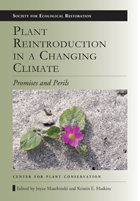
Plant Reintroduction in a Changing Climate
Promises and Perils
Edited by Joyce Maschinski and Kristin E. Haskins
Island Press, 2011
Considered an essential conservation tool, plant reintroductions have been conducted for many of the world's rarest plant species. The expertise and knowledge gained through these efforts constitute an essential storehouse of information for conservationists faced with a rapidly changing global climate.
This volume presents a comprehensive review of reintroduction projects and practices, the circumstances of their successes or failures, lessons learned, and the potential role for reintroductions in preserving species threatened by climate change. Contributors examine current plant reintroduction practices, from selecting appropriate source material and recipient sites to assessing population demography.
The findings culminate in a set of Best Reintroduction Practice Guidelines, included in an appendix. These guidelines cover stages from planning and implementation to long-term monitoring, and offer not only recommended actions but also checklists of questions to consider that are applicable to projects around the world.
Traditional reintroduction practice can inform managed relocation-the deliberate movement of species outside their native range-which may be the only hope for some species to persist in a natural environment. Included in the book are discussions of the history, fears, and controversy regarding managed relocation, along with protocols for evaluating invasive risk and proposals for conducting managed relocation of rare plants.
Plant Reintroduction in a Changing Climate is a comprehensive and accessible reference for practitioners to use in planning and executing rare plant reintroductions.
This volume presents a comprehensive review of reintroduction projects and practices, the circumstances of their successes or failures, lessons learned, and the potential role for reintroductions in preserving species threatened by climate change. Contributors examine current plant reintroduction practices, from selecting appropriate source material and recipient sites to assessing population demography.
The findings culminate in a set of Best Reintroduction Practice Guidelines, included in an appendix. These guidelines cover stages from planning and implementation to long-term monitoring, and offer not only recommended actions but also checklists of questions to consider that are applicable to projects around the world.
Traditional reintroduction practice can inform managed relocation-the deliberate movement of species outside their native range-which may be the only hope for some species to persist in a natural environment. Included in the book are discussions of the history, fears, and controversy regarding managed relocation, along with protocols for evaluating invasive risk and proposals for conducting managed relocation of rare plants.
Plant Reintroduction in a Changing Climate is a comprehensive and accessible reference for practitioners to use in planning and executing rare plant reintroductions.
[more]
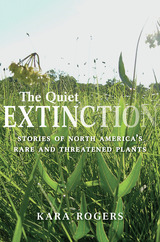
The Quiet Extinction
Stories of North America’s Rare and Threatened Plants
Kara Rogers
University of Arizona Press, 2015
In the United States and Canada, thousands of species of native plants are edging toward the brink of extinction, and they are doing so quietly. They are slipping away inconspicuously from settings as diverse as backyards and protected lands. The factors that have contributed to their disappearance are varied and complex, but the consequences of their loss are immeasurable.
With extensive histories of a cast of familiar and rare North American plants, The Quiet Extinction explores the reasons why many of our native plants are disappearing. Curious minds will find a desperate struggle for existence waged by these plants and discover the great environmental impacts that could come if the struggle continues.
Kara Rogers relates the stories of some of North America’s most inspiring rare and threatened plants. She explores, as never before, their significance to the continent’s natural heritage, capturing the excitement of their discovery, the tragedy that has come to define their existence, and the remarkable efforts underway to save them. Accompanied by illustrations created by the author and packed with absorbing detail, The Quiet Extinction offers a compelling and refreshing perspective of rare and threatened plants and their relationship with the land and its people.
With extensive histories of a cast of familiar and rare North American plants, The Quiet Extinction explores the reasons why many of our native plants are disappearing. Curious minds will find a desperate struggle for existence waged by these plants and discover the great environmental impacts that could come if the struggle continues.
Kara Rogers relates the stories of some of North America’s most inspiring rare and threatened plants. She explores, as never before, their significance to the continent’s natural heritage, capturing the excitement of their discovery, the tragedy that has come to define their existence, and the remarkable efforts underway to save them. Accompanied by illustrations created by the author and packed with absorbing detail, The Quiet Extinction offers a compelling and refreshing perspective of rare and threatened plants and their relationship with the land and its people.
[more]
READERS
Browse our collection.
PUBLISHERS
See BiblioVault's publisher services.
STUDENT SERVICES
Files for college accessibility offices.
UChicago Accessibility Resources
home | accessibility | search | about | contact us
BiblioVault ® 2001 - 2024
The University of Chicago Press









